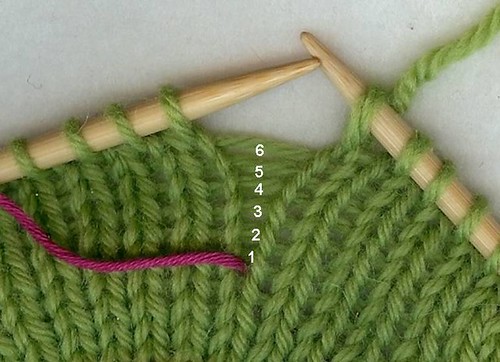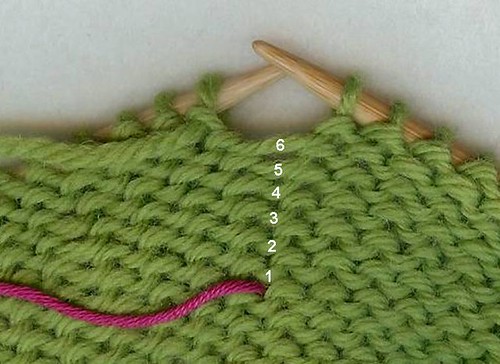I’m glad so many of you found my counting tips helpful, though I left out a really important part of the explanation that shows why this method is easier than flipping row counters and marking hash marks after every row.
For the following to make sense (and probably a lot of you already understood what I was trying to say!), you’ll need to read yesterday’s post first.
In the example from yesterday, we are doing sleeve increases every 6 rows and using waste yarn to mark when the increases are done. Once you have worked 6 rows above the waste yarn, you do the next increase, right?
BUT, how am I supposed to keep track of those 6 rows — by using a row counter or hash marks? How is that helpful or easier? This is where your knitting does the work for you. All you do is count the “ladders” above the waste yarn (i.e., running thread) between sts and you can see when the 6 rows are done and you are ready for the next increase:

On the reverse side, you can count bumps.

With garter stitch, I count ridges.

So, I do count something — but it’s my knitting that is keeping track for me.
Thanks for putting up with more on this topic!
PS — Jen had this question:
“I wasn’t confused before, but now I am. If you’re increasing every 6 rows, and count 6 ladders and THEN increase, doesn’t that mean you’re increasing every 7th row? Have I been doing this wrong all along? I thought Increasing every 6 rows meant increasing every sixth row and not having 6 rows between each increase row.”
Jen, you are correct and what I am doing is exactly what you have been doing. The first ladder is created on the row you actually do the increase = row 1 of the 6 rows in question. Then you knit 5 plain rounds. This equals the 6 ladders. The next row is an increase row again: row 1 of the next 6.
You could move your waste yarn from front to back (or back to front) on the row after you complete the increase, and then work 5 rows plain with the last row of the 6 being the increase row. I just find it easier to move the waste yarn on the row that I do the thing I am counting, so I don’t forget.

















very interesting and clever ! thank you !
Comment by Dodile — April 2, 2009 @ 3:03 am
Susan- I learned something similar from a Meg Swansen video, on how to tell what row to cable on.
So much better than those barrel counters and papers that end up down the side of the sofa.
You are clever!
Comment by Lorraine — April 2, 2009 @ 10:24 am
Now that I’m 43, my near vision isn’t good enough to count bumps, and I’m too sloppy to keep track of reading glasses, so I do a modified version of your waste-yearn row-tracking method: I flip the waste yarn back and forth at EVERY row, and make a knot in it where I increase or decrease. That way, the waste yarn counts the rows for me and I don’t have to squint at it.
Comment by victoria — April 2, 2009 @ 11:03 am
This visual was SO helpful in illustrating what your first post meant. Thank you so much for adding it!
Comment by Libby — April 2, 2009 @ 12:07 pm
Wouldn’t that section of garter stitch actually contain 10 rows? Because garter stitch makes a ridge on every other row… If I am wrong, forgive me for cheeking a Rainey!
Comment by Shannon B — April 2, 2009 @ 12:46 pm
“Thanks for putting up with more on this topic!”
On the contrary, I am glad to see this technique explained so fully. I had heard of it but missed some crucial parts. I will be trying it soon on some sleeves.
Comment by Valerie — April 2, 2009 @ 7:33 pm
Yes. Two rows of knitting equals one garter ridge. I think what Susan meant is that instead of counting rows when she is working in garter, she counts ridges b/c it is easier. So, if you were decreasing every 6 rows, that would be 3 ridges. Her example is from her Ode to Joy (at least it looks like it to me), and she is probably doing her decreases every five or six ridges (which would be ten or twelve rows) b/c garter stitch row gauge is so compressed.
Comment by surly — April 2, 2009 @ 11:59 pm
From Susan — Yes, on my Ode to Joy, I am doing my decreases every 8 rows (4 ridges) and then every 10 rows (5 ridges) and counting ridges instead of rows…though really it is the same concept.
Comment by lv2knit — April 3, 2009 @ 12:46 am
I wasn’t confused before, but now I am. If you’re increasing every 6 rows, and count 6 ladders and THEN increase, doesn’t that mean you’re increasing every 7th row? Have I been doing this wrong all along? I thought Increasing every 6 rows meant increasing every sixth row and not having 6 rows between each increase row.
Comment by Jen Anderson — April 3, 2009 @ 11:17 am
No. If you look carefully at the directions, that’s not what she said. Think of it this way. You are knitting a sleeve with the increases on each side. You work the increase and knit a few stitches. I’m going to call the last stitch on the right needle, which you just worked, Stitch A. Then you place the waste yarn and knit the next stitch, Stitch B. When you knit Stitch B, the waste yarn is “trapped” between the running thread that goes between Stitch A and B. So, when you are counting those “ladders,” that’s the first rung in the ladder.
1. Row you worked the increase on
2. First row after increase
3. Second row after increase
4. Third row after increase
5. Fourth row after increase
6. Fifth row after increase.
So, you have counted six rungs, and the next row — the sixth row after the increase — is where you will increase again. In effect, that first rung is really “row zero” in a way. Does that help?
Comment by surly — April 3, 2009 @ 2:58 pm
I understand now, thanks!
Comment by Jen Anderson — April 3, 2009 @ 3:24 pm